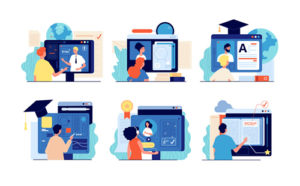When the pandemic began a year ago, it brought unforeseen problems and changes to every industry, but especially to higher education. Schools everywhere suddenly experienced upheaval as full remote online learning or a hybrid of in-person/online learning became the “new normal.”
Before the pandemic, analysts projected that the global e-learning market expansion would reach a whopping $336.98 billion by 2026, and forecasts predicted e-learning in the United States was expected to reach $6.22 billion in 2022. Now, nearly a year into the global pandemic, the global e-learning market expansion is expected to exceed these numbers.
More than 19 million college students have chosen to continue their studies remotely instead of on campus. As a result, information technology departments now play a critical role in the student and faculty experience–this goes far beyond typical network and ticketing requests. Unfortunately, many IT departments in higher education were not properly prepared to accommodate the first wave and 159 percent increase in remote work from 2004 – 2017. Therefore, they had to catch up to accommodate today’s rapid, forced demand.
The uncertainty associated with the pandemic, despite vaccine rollout, means higher education must prepare for anything, which includes innovative technology and convenience. Higher ed must invest in a stable yet flexible service management infrastructure, making IT departments the focal point to support it.
To transition to remote or blended learning, universities must optimize infrastructures to make the user experience and transition as seamless as possible.
How do they get there? What is the guide? The following recommendations can help university IT departments as they work to further improve student experiences for virtual learning and the future:
Automated ticketing systems
Automating as much of the IT process as possible will save time and enable teams, with the ability to create their own templates and processes. By automating ticketing systems, users will have more flexibility to adjust the platform as necessary to meet changing requirements. This will also enhance their ability to provide users with automated notifications for visibility on their IT requests’ status, allowing them to feel more informed and assured that their problems are being resolved.
Online security and support options for staff and students
With nearly all university platform users accessing systems from different places and devices, network security is vital on campus and online. IT departments must take it upon themselves to guide users to review the risk and compliance frameworks and review security incident response policies. With so many users accessing a university platform from numerous locations, security has become of the utmost importance to help students and faculty achieve a seamless experience.
Strengthening cross-department functionality and collaboration
IT departments can easily maintain operations with self-service systems and provide users with answers when they need support by creating a one-stop-shop for students and faculty to engage with one another directly. A self-service portal allows users direct access and insight into their IT problems and can help users easily resolve those problems.
Pairing self-service systems with what is known as “knowledge management,” IT users themselves can resolve problems. Knowledge management creates an accessible virtual library with the potential to cover all types of campus-related topics that students and faculty members can rely on to find answers when needed.
Streamlining processes with omnichannel support
Accessibility and omnichannel support may seem like antiquated processes, but they have become increasingly essential. Universities must keep in mind that everyone has individual preferences, and omnichannel tech can help accommodate the various situations users find themselves in. With remote users, it’s critical that everyone has access to the network on different devices, not only for email but also to engage and work. Universities must be able to accommodate the growing needs of evolving technology.
Using Low-Code/No-Code solutions to elevate experiences quickly
Embracing reliable, easy-to-use Low-Code or No-Code systems allows users to quickly deploy revised workflows. Universities with IT teams working directly and effectively on digital transformation efforts with support from a low-code/no-code system will thrive as they save vast amounts of time in code creation and support, while bypassing the need to create new code and bring in software engineers to implement changes.
Low-code/no-code will allow IT to upgrade user platforms and elevate user experience continuously.
There is no time frame for the pandemic – it is unpredictable and impossible to know the potential continued disruption it may bring. Despite the unknown circumstances, we can do better for remote learning to address current problems to prepare for the near-term and long-term future in higher-education.
A year into the pandemic, we can see how the IT department’s service capabilities have either allowed a university to thrive or struggle – but it is never too late for universities to upgrade their tech stacks. Moving forward, IT departments must remain agile in how technology structures are built so higher-education can continue to evolve alongside user preferences and technology advancements.
- How we connect incoming students to the university resources they need - July 4, 2025
- AI and the workforce: Reskill to meet the moment - July 1, 2025
- Beyond the game: Why business expertise is the future of sports management - June 26, 2025
